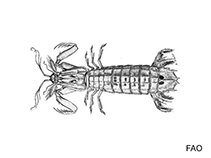Squilla parva Bigelow, 1891
Small mantis shrimp| Native range | All suitable habitat | Point map | Year 2050 |

|
| This map was computer-generated and has not yet been reviewed. |
| Squilla parva AquaMaps Data sources: GBIF OBIS |
Google image | No image available for this species;
drawing shows typical species in Squillidae.
Classification / Names Common names | Synonyms | CoL | ITIS | WoRMS
Malacostraca | Stomatopoda | Squillidae
Environment: milieu / climate zone / depth range / distribution range Ecology
Benthic; depth range 7 - 120 m (Ref. 3620). Tropical; 25°N - 4°S, 108°W - 78°W
Distribution Countries | FAO areas | Ecosystems | Occurrences | Introductions
Eastern Pacific: from Sinaloa, Mexico to Mancora, Peru.
Length at first maturity / Size / Weight / Age
Maturity: Lm ? range ? - ? cm Max length : 7.7 cm TL male/unsexed; (Ref. 121707)
Life cycle and mating behavior Maturity | Reproduction | Spawning | Eggs | Fecundity | Larvae
Main reference
References | Coordinator | Collaborators
Landa-Jaime, V., J. Arciniega-Flores, R.G. de Quevedo-Machain, J.E. Michel-Morfin and G. González-Sansón. 1997 Soft-bottom decapod and stomatopod crustaceans of the continental shelf off Jalisco and Colima, Mexico. Ciencias Marinas 23(4):403-417. (Ref. 3616)
IUCN Red List Status
(Ref. 130435: Version 2025-1)
CITES status (Ref. 108899)
CMS (Ref. 116361)
Threat to humans
Human uses
Fisheries: commercial
| FishSource |
Tools
More information
Max. ages / sizes
Length-weight rel.
Length-length rel.
Length-frequencies
Mass conversion
Abundance
Internet sources
BHL | BOLD Systems | CISTI | DiscoverLife | FAO(Publication : search) | Fishipedia | GenBank (genome, nucleotide) | GloBI | Gomexsi | Google Books | Google Scholar | Google | PubMed | Tree of Life | Wikipedia (Go, Search) | Zoological Record



